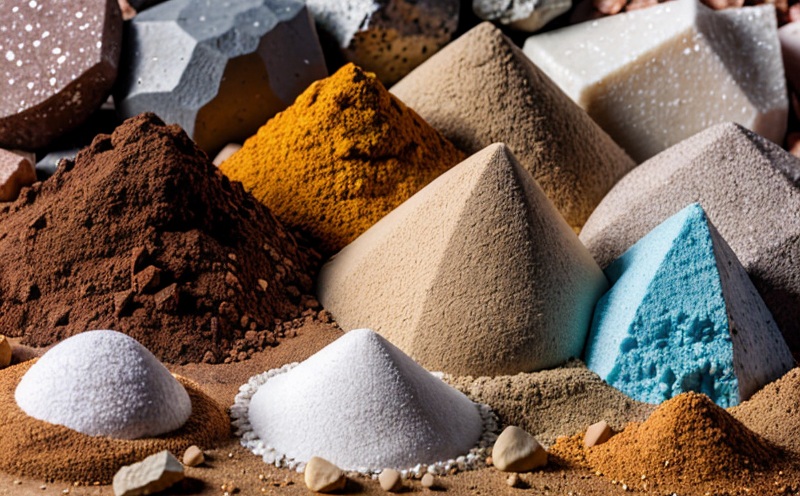DIN 22036 Moisture Content in Mineral Raw Materials Testing
The DIN 22036 standard is an internationally recognized method used for determining the moisture content of mineral raw materials. This testing process is critical for quality management, compliance, and R&D within the mining industry as it ensures that products meet specified standards, thus impacting product performance and efficiency.
Mineral raw materials often contain varying levels of water content which can significantly influence their properties and subsequent processing stages. The accurate determination of moisture content is essential for ensuring consistency in quality and preventing potential issues during production processes. This testing method provides a reliable means to measure the moisture content, thereby supporting effective decision-making related to mining operations.
The procedure outlined in DIN 22036 involves drying a sample under controlled conditions until it reaches a constant weight, after which the difference between the initial and final weights is used to calculate the percentage of moisture present. It's important to note that this standard applies not only to solid minerals but also certain types of slurries or paste-like materials.
The precision achieved through this method ensures that all parties involved—from raw material suppliers to manufacturers—are aware of any variability in moisture content, allowing for more accurate forecasting and inventory management. Additionally, by adhering to such standards, companies can demonstrate their commitment to maintaining high levels of quality control across their supply chains.
For those looking to understand how this testing process works in practice, consider the following steps:
- Select a representative sample from the batch or stockpile according to the specified sampling protocol.
- Prepare the sample by breaking it down into smaller pieces if necessary and then grind it sufficiently so that all particles pass through a designated mesh size.
- Weigh an appropriate amount of this prepared sample accurately using an analytical balance.
The sample should be placed in a container designed specifically for heating purposes, ensuring no loss of moisture during the process. Place this container into an oven preheated to 105°C ± 2°C and allow it to dry until reaching a constant weight. Once achieved, remove the container from the oven and cool it down to room temperature before weighing again.
The difference between these two weights represents the mass of water lost during drying, which can then be expressed as a percentage relative to the initial sample mass. Compliance with DIN 22036 helps ensure consistency across different batches or suppliers, minimizing variability in product performance and reducing waste associated with excessive moisture levels.
To further illustrate its application within mining operations, here are some key points highlighting where this testing method finds relevance:
- During procurement: Ensuring that purchased raw materials conform to agreed-upon specifications regarding moisture content helps prevent discrepancies between expected and actual performance.
- In inventory management: Accurate knowledge of the moisture levels allows for better stock rotation strategies, reducing spoilage risks due to excess humidity.
- During processing optimization: Understanding how much water is present in raw materials enables adjustments to be made during preparation stages, optimizing processes and maximizing yields.
Benefits
The implementation of DIN 22036 moisture content testing offers numerous advantages for mining operations. By ensuring consistent quality throughout the supply chain, companies can reduce costs associated with rework or scrap due to poor material performance.
This standard also supports regulatory compliance by providing a robust framework that helps organizations meet industry-specific requirements. Furthermore, it enhances operational efficiency through informed decision-making based on accurate data about raw material characteristics.
For quality managers and R&D engineers specifically, this testing method provides valuable insights into the properties of various mineral types under different conditions. This knowledge can be used to develop more efficient processing methods or improve existing ones, leading to significant improvements in overall productivity.
Industry Applications
| Type of Mineral | DIN 22036 Moisture Content Range (%w) |
|---|---|
| Iron Ore (Fe) concentrate | ≤1.5 |
| Copper Sulphide Concentrate | ≤2.0 |
| Zinc Concentrate | ≤3.0 |
The DIN 22036 moisture content testing is widely used across various types of minerals commonly found in mining operations, including iron ore, copper sulfide concentrate, and zinc concentrate among others.
- It ensures that these materials meet the specified limits set by the standard, thereby guaranteeing their suitability for further processing steps.
- This testing method plays a crucial role in maintaining consistent quality standards across different batches or suppliers of raw materials.
Customer Impact and Satisfaction
The use of DIN 22036 moisture content testing has several positive impacts on customers. Firstly, it leads to improved product quality which directly translates into customer satisfaction by delivering reliable performance across multiple applications.
- For industrial users like steel manufacturers who rely heavily upon iron ore as a key component in their production processes, accurate knowledge of moisture content ensures that the final product meets exacting standards.
- In construction sectors where materials such as zinc concentrates are used for roofing or siding applications, ensuring proper drying prior to installation prevents premature degradation caused by excess moisture.
By adhering to this standard, mining companies not only enhance their own reputation but also contribute positively towards the broader supply chain. This contributes significantly to overall customer satisfaction and trust in the industry's offerings.





